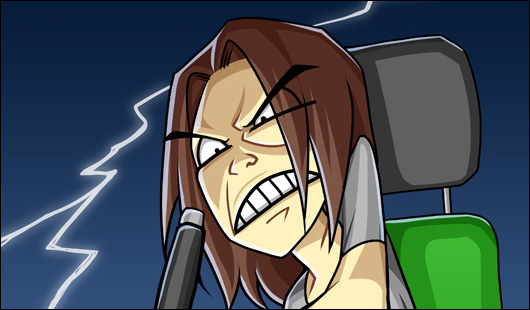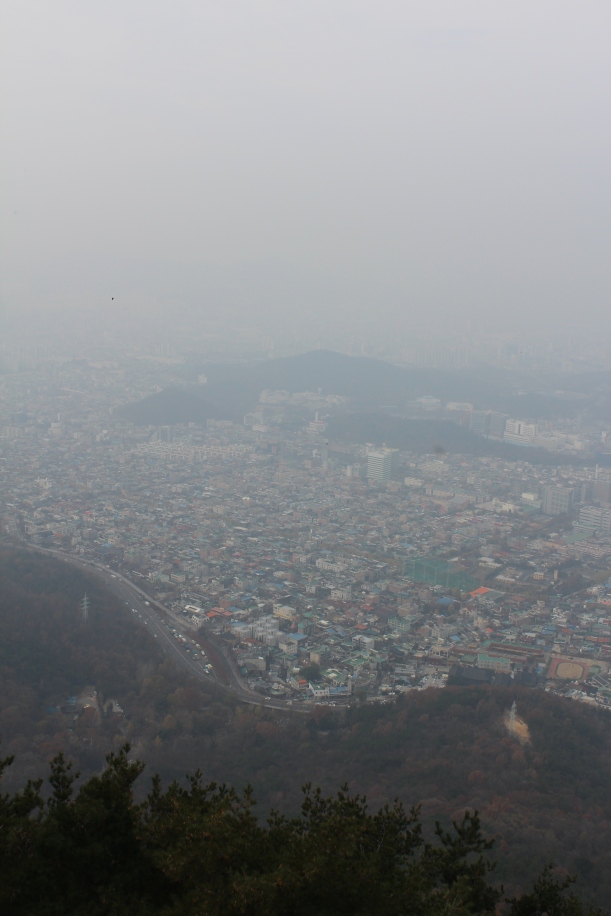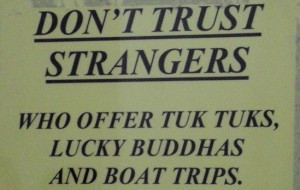by Kellyn Gross
“Geonbae!”
“Bottoms up.”
He raises his shot glass in the air, striking hers as she does the same. Soju spills, dripping onto a stained blue checkered tablecloth. A sudden laugh escapes her pursed lips. She downcasts her eyes and smooths her pants. Her pale make-up no longer conceals her flushed face.
“To us!” The young man brings the glass to his lips, and tilts his head back as he gulps the clear liquor. His plastic stool wobbles, and he clasps the round table to brace himself. Unsuccessful, he falls against the orange tent wall. A broad smile forms on his round face, and he gingerly places his glass down.
“To us.” A loose bun at the nape of her neck unfurls. She pats it with her left hand. The young woman sips down her drink and smirks.
It’s four o’clock in the morning and cold. Yellow traffic lights flash through the tent’s clear, plastic windows, and smells of frying oil, cigarettes and booze linger. The man sets two empty soju bottles upright and pushes them across the table to join another three. They clang and fall over again. The woman picks up each of the four charred skewer sticks and tosses them into the small garbage tin by their feet. They are the only diners in this street food stall.
“More side dishes and another soju. Oh, and four more fish cake skewers, please.” He waves at the old woman sitting behind steaming vats of broth and skewered meats. The squat proprietor slides her blanket off her lap, slowly stands up and limps past the counter to a fridge lined with bottles of soda, soju, rice wine and beer. He looks at her stooped frame and dashes to her with the empty dishes. Their eyes scarcely meet.
“Thank you.” The man bows earnestly as he takes the bottle from her.
“Yes.” She returns to her station to refill the dishes, occasionally stopping to listen to the radio drama droning on behind her.
“I’m glad you asked me to join you.” She sighs and hugs her coat lapels close to her chest as he sits back down. “You saved me from drinking alone.”
“I’m glad you said yes. So, do you think we have drank enough to forget our problems?” He twists the soju cap off with a quick motion and tips the bottle toward her. She holds her glass with two hands and accepts his pour.
“No, but maybe after this one.” They both laugh, and she pours a drink for him as well. She looks at his scuffed fingernails and the dirt smudges on his hands. “You said that your family is from Taegu, right?” Her hands are smooth and clean.
“Yes, Taegu. But I moved to Seoul about six years ago. My mom was working here first.”
“Tell me more about Peace Market. Do you like your job?” His wide-set eyes steady on her in silence before he looks down. He doesn’t wait for a toast and drinks the entire shot.
“No, I don’t.” The old woman returns, placing dishes of dried squid, chili pepper sauce, peanuts and a plate of four fish cake skewers on the table. He pours himself another shot and knocks it back.
“I usually have to work 14 hours a day, and I even work on Sundays. Work starts in a few hours, really. But we aren’t paid overtime. The seamstresses operate the sewing machines until late at night. They all have health problems. They’re only middle-school girls, working 15 hours a day.”
“Middle-school girls?”
“Yes. I don’t know how they can stand it. There is no ventilation, and the fumes are horrible. They can’t afford to eat more than a bowl of ramen a day. Hell, neither can I most days.” She wrings her hands, and her eyes search his face for answers to these troubling stories.
“You look cold. Here. Take my jacket.”
“No, I’m okay. I’m just shocked by this information.”
“Please. I insist.” He removes his brown jacket and drapes it over her shoulders.
“Thank you.”
“It’s my pleasure.”
“So, do you operate the sewing machines, too?”
“No, I’m a fabric cutter. I get extra money for the job, but it’s very little.” He stuffs a skewer in his mouth and rakes off the fish cake with his front teeth. “The shop I work in is no bigger than this pojangmacha.” He gestures toward the tent walls with the skewer, then sees she isn’t eating. “Please, help yourself.” She takes the skewer from his outstretched hands and spins it between her fingers before eating the fish cake.
“Thanks. Have you tried telling labor inspectors?”
“I’ve tried, but they just say they’ll inspect shops and never do. I say to them, we’re not machines! But they don’t listen. Why should they? Even our president ignores labor regulations. Which reminds me, I bought a copy of the Korean Labor Standards Act.”
“What’s that?” She takes another skewer and nibbles the sides of the fish cake.
“The act is supposed to protect workers and their rights. I’m teaching myself hanja to read the document, but it’s difficult and slow. I wish I had a university friend to help me. Do you know how to read hanja?” She is not only studying at Sogang University, but she studied hanja throughout primary and secondary school.
“N-no I don’t. I-I-I’m really sorry I can’t help you.” Her lips barely move, and she is almost inaudible.
“That’s okay. It’s all in the act, though. Workers are guaranteed proper wages and eight-hour workdays by law, as well as Sundays off and regular health exams. But I’m learning that the law is nothing but a piece of paper.”
“It’s not right.”
“No, no it’s not. And it keeps me up at night. What about you? You still haven’t said why you were drinking alone on a Saturday night.”
“Nevermind. It’s nothing, really.”
“No, I want to know. I’m listening.” He peers at her as she fiddles with her skewer.
“First, let’s toast.” She quickly chews the last bite of fish cake.
“Oh, of course. Cheers! To workers!” The fabric cutter pours himself another shot, and together with the university student, they raise their shot glasses in the air. Soju spills again onto the stained tablecloth before the glasses reach their mouths.
“So? What’s worrying you?” She hesitates to respond and then peeks at her silver wristwatch.
“You know, it’s almost 5am. I should go home. Can we talk about this another time?”
“Uhh. Of course. Do you live nearby? I can walk you home.”
“I’d rather walk alone if that’s okay. Not that I haven’t appreciated my time with you, but it’s more proper this way.”
“Okay, I understand. So, I guess this is good night? Or good morning?” He chuckles.
“Either way, I guess it is. First, I should give you some m—”
“No, I’ll pay.”
“But I drank and ate just as much as y—”
“No, I’m your older brother. I was born in 1948, remember?”
“I remember, I just thought—”
“Really, it’s okay.”
“Well, thank you so much for your kindness.”
“You’re welcome.” He pulls out a handful of coins from his front pocket and approaches the old woman at the counter. Their eyes still scarcely meet.
“Here you are. We ate well. Thank you.”
“Yes. Come again.” The young man and young woman exit through the front door and face each other on the sidewalk.
“Let’s meet again.” He shoves his hands in his pockets.
“Okay. When and where?”
“How about here next Saturday? But let’s meet in the afternoon instead.”
“Yes, good thinking.” She teeters back and forth on her heels to stay warm in the chilly November air.
“Well, nice to meet you, and I’ll see you in a week. Good-bye.”
“Good-bye.” She smiles and bows. He smiles in return and hurries down the sidewalk toward the orange glow of sunrise at the street’s horizon.
Good-bye. Wait.
“Hey! I don’t know your name! I still have your jacket!” She starts to run after him.
“Aaeesh! Yelling won’t help. He’s gone. Besides, you’ll see him again.” The old lady clucks her tongue, arms akimbo. She limps past the plastic doorway to sit once again behind vats of broth and fried food.
The young woman stops. She places her hand above her heart, tracing the edges of a name tag with her finger. She looks down and reads the white letters set against the black background.
“Jeon Tae Il.” Smoke from the tented restaurant wafts in the air. The old woman turns up the volume on her radio. The red sun rises over the cemetery, and the sweltering midday heat is my hardship. Now, I leave to the wilderness. Leaving all sorrow behind, now I go.
Park Geun Hye is startled awake. She’s in her arm chair on the second floor of the Blue House.
Am I smelling smoke? Her cellphone rests on a table next to her. She picks it up and speed dials her assistant.
“Tomorrow morning is a national labor rally in memory of Jeon Tae Il, no?
“Yes, Madam President, that’s correct. Unions will be mobilizing tomorrow at City Hall, although the exact date of his memorial is November 13th. Forgive me, but if you were considering trying to visit the Jeon foundation again, I think that given what happened last y–”
“No, I won’t be attempting to visit the foundation. But I did promise last year at his monument to make a country where laborers are happy.”
“I see, Madam President. I’m not sure w–”
“What time are protesters gathering tomorrow?”
“I believe at ten o’clock. Approximately 200 combat police and riot control personnel will be on stand by surrounding the US embassy per protocol. Would you like to speak with Mayor Park Won Soon and suggest a stronger police presence?”
“No, I most assuredly do not. But do arrange a car pick up for me at eight o’clock en route to City Hall.”
“But, Madam President, I don’t think that’s possible. Tomorrow is Sunday, and you have your weekly security meeting with advisor Chun Yung Woo.”
“Well, call him to reschedule for Monday. I also want to contact labor organizers tonight. Can you help me do that? Can you get KTCU members or Ssangyong Motors people on the phone?”
“I can try, but Madam P–”
“Good. I want to speak with any labor representative whom I can. And I need to address the protesters tomorrow.”
“B-b-but Madam President, this is highly unorthodox.”
“I know. But I made a promise to workers. An-an-and I just haven’t done that. It’s time I did.”
“Madam President, I’m sorry, but I don’t understand this. I mean, why?”
“Why? Because I want to be the friend to workers my father wasn’t before—that I wasn’t before. As you know, my memorial business has always been to my father.”
“Yes, Madam President, of c–”
“But my memorial business should include workers like Jeon Tae Il who have made great sacrifices.” She stared at her father’s solemn portrait on the far wall, then gazed out the window.
“It’s taken a single spark, and it can’t be put out.”
This short story is inspired by the protest that our media team attended on November 9th of this year, and by the workers’ rights activist Jeon Tae Il who self-immolated himself on November 13, 1970. He was protesting horrendous working conditions in garment factories under Park Chung Hee’s dictatorship. His struggle lives on under Park Geun Hye’s administration.
![]()
![]()
















































_html_1f102a18.jpg)
_html_m2b129f14.jpg)
_html_m72ccc917.jpg)
_html_5fa051f6.jpg)
_html_5053cd67.jpg)
_html_m103063e0.jpg)
_html_m4ff2fee2.jpg)
_html_3798d7b6.jpg)
_html_m62ad0d39.jpg)
_html_m4080c17a.jpg)
_html_m5f7a28ad.jpg)

















































